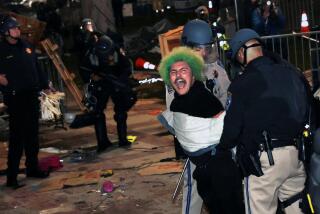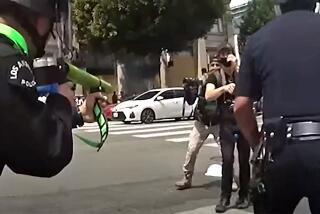Protester had hands up when LAPD officer shot him in head with projectile, video shows

Footage from a Los Angeles police officer’s body camera shows a man with his hands up being shot in the head with a tactical round as officers advanced on a crowd of fleeing protesters on May 30.
Footage from a Los Angeles police officer’s body camera shows a man with his hands up being shot in the head with a tactical round as officers advanced on a crowd of fleeing protesters on May 30.
The man, CJ Montano, was standing in the middle of a street in the Wilshire area after taking several steps backward as officers on skirmish lines in front of him screamed “Less lethal!” and “Leave the area!” As the officers began firing at protesters as they fled, Montano can be seen dropping to the ground, then being rushed away from the scene by other protesters.
The footage is the first from officers’ body cameras to be made public from a large protest in the Fairfax district that has spurred debate over police tactics, lawsuits, calls for reforms and internal investigations. It offers new insights into how the LAPD handled an intense flashpoint of the protests and unrest.
The video shows officers firing projectile rounds to push protesters east along Beverly Boulevard near CBS Television City after several earlier clashes.
After being shot, Montano, a 24-year-old music student and former U.S. Marine, was hospitalized for four days, two of them in the intensive care unit with serious bleeding in his brain, he said Friday. He is still recovering from a range of symptoms.
His shooting is under investigation by the LAPD’s Force Investigation Division.
In a video produced and released Friday by the LAPD that includes the body-camera footage, Capt. Gisselle Espinoza, an LAPD spokeswoman, said “the circumstances of how Montano was struck, and which officer fired the less-lethal projectile that struck Montano, is still under investigation” as an “unintentional head strike.”
The department would not comment as to why the shooting had already been deemed “unintentional,” citing the ongoing nature of the investigation. However, a source familiar with the investigation said the classification of the shooting as “unintentional” was based on interviews with the two officers whom the department identified as having fired their weapons at the time.
Police said they have tried to interview Montano, without success.
Montano, who has filed notice with the city of his intention to sue unless he is compensated for having been injured so grievously, said he told the police that they should contact his attorneys. He said the video — which his attorneys had previously requested but were never given — corroborates what he has said all along about the circumstances surrounding his shooting: that he had presented no threat to the police.
“I just want everyone to see how oppressive the police force is as a whole in the United States, and what they are doing to people who literally, as you can see in the video, are backing up with their hands up,” he said. “It’s just sickening.”
“He is isolated in that intersection. His arms are up in the air. There’s no good argument that he was hit accidentally,” said Timothy A. Loranger, one of Montano’s attorneys. “He was specifically targeted, and he was hit. This was not an accident.”
Montano served in the Marines from 2014 to 2018 and was unable to attend demonstrations while on active duty, he said. That day in May, he had decided it was finally time for him to stand up with others and “show that I was sick of seeing the injustices occurring, specifically against Black people.”
He had been near the skirmish lines in part to help others who sustained injuries from police, he said. He said that he at no point presented a threat to police and had even told others in the crowd not to throw things at officers.
By policy, the LAPD releases footage from incidents in which officers cause “serious bodily injury” after 45 days, though the department has the discretion to share video sooner. The Times filed a public records request last month for footage from all such incidents during the protests.
Monique Alarcon, another of Montano’s attorneys, said they also filed a public records request for footage of Montano’s shooting and were surprised Friday when they learned the LAPD had “decided to first put together a PR video and release it to the public.”
A Times investigation has found LAPD officers likely violated protocols for the use of batons and tactical weapons during the protests that day in the Fairfax district. Many protesters were injured, including by the sponge and foam bullets and beanbag rounds that officers fired.
The LAPD is investigating 125 separate complaints from the protests, including 54 involving officers using force, police said. A total of 10 officers have been removed from field duties pending investigations.
The clashes began after a planned protest at Pan Pacific Park. While many protesters say police in riot gear targeted a peaceful demonstration, escalated tensions and instigated the clashes, police allege that protesters or other agitators among them had turned violent and created a dangerous situation for themselves and others, including officers.
After several police cars were lit on fire, and outnumbered officers reported being targeted with rocks and bottles, LAPD Chief Michel Moore declared the gathering unlawful, and police began using batons and tactical guns to disperse the crowd.
Asst. Chief Robert Arcos, who oversees LAPD operations, has previously said that officers that day were firing at specific targets and not simply to disperse or push back crowds. Department policy requires such weapons be used only on individuals who are targeted for presenting a clear and immediate threat. It requires that officers aim for the person’s navel or belt line, then their arms and legs, and never their head or neck.
Officers are not supposed to fire the weapons at people who are fleeing an area.
Josh Rubenstein, another police spokesman, said the department has not made any determination yet as to whether policy was followed in Montano’s shooting. Any such finding would come after the conclusion of the ongoing investigation, he said.
Montano, who that day had carried a sign reading, “We can’t be silent when cops are violent,” said he believes he was targeted, brutally and in clear violation of department policies, and he believes that is clear in the video.
“It just feels like it was all intentional, and it makes me feel sick,” he said.
Today, Montano uses a cane because of vertigo. He used to work out often but can’t do so anymore. His doctors have told him not to lift anything larger than a gallon, so he needs help to carry groceries inside, he said.
Pedram Esfandiary, another of his attorneys, said Montano remains at risk for seizures, has trouble following some social cues, regularly experiences dizziness and has trouble listening to music — a serious issue for a music student.
“My quality of life essentially has kind of 180’d,” Montano said. “It’s just unending in terms of the recovery.”
Apart from Montano’s pending case, the department is facing several lawsuits over its tactics, including a major class-action lawsuit filed by Black Lives Matter-L.A. and other activist groups. Like Montano, the plaintiffs in that case want to see an end to the LAPD’s use of projectiles on protesters.
Melina Abdullah, one of the co-founders of Black Lives Matter-L.A., said the new video adds to an array of evidence showing that police approached the Fairfax protest “with an eye toward harming protesters” and helps make clear the true danger of such weapons.
“We had many, many folks who were seriously injured at that protest,” she said. “Just because they use the term ‘less lethal’ does not mean that it’s not lethal. It does not mean that it’s not harmful.”
More to Read
Sign up for Essential California
The most important California stories and recommendations in your inbox every morning.
You may occasionally receive promotional content from the Los Angeles Times.











